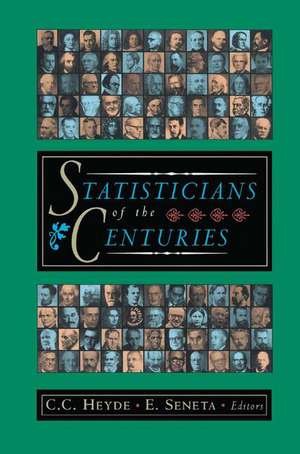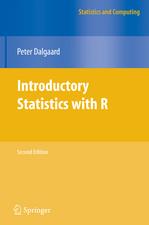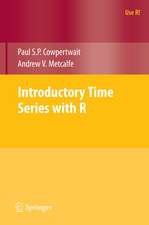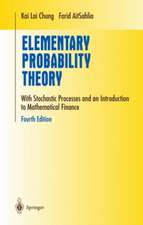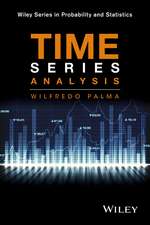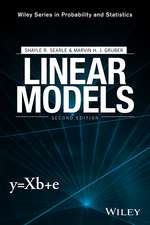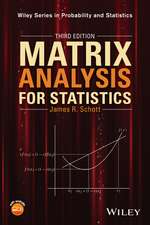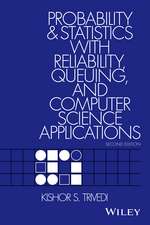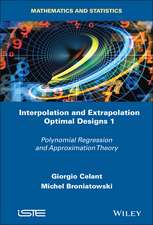Statisticians of the Centuries
P. Crepel Editat de C.C. Heyde S.E. Fienberg Editat de E. Seneta J. Ganien Limba Engleză Paperback – 9 aug 2001
The editors are the well-known statisticians Chris Heyde and Eugene Seneta. Chris Heyde is Professor of Statistics at both Columbia University in New York and the Australian National University in Canberra. He is also Director of the Center for Applied Probability at Columbia. He has twice served as Vice President of the ISI, and also as President of the ISI's Bernoulli Society. Eugene Seneta is Professor of Mathematical Statistics at the University of Sydney and a Member of the ISI. His historical writings focus on 19th Century France and the Russian Empire. He has taught courses on the history of probability-based statistics in U.S. universities. Both editors are Fellows of the Australian Academy of Science and have, at various times, been awarded the Pitman Medal of the Statistical Society of Australia for their distinguished research contributions.
| Toate formatele și edițiile | Preț | Express |
|---|---|---|
| Paperback (1) | 400.85 lei 6-8 săpt. | |
| Springer – 9 aug 2001 | 400.85 lei 6-8 săpt. | |
| Hardback (1) | 657.57 lei 6-8 săpt. | |
| Springer – 24 aug 2001 | 657.57 lei 6-8 săpt. |
Preț: 400.85 lei
Nou
Puncte Express: 601
Preț estimativ în valută:
76.71€ • 80.45$ • 63.85£
76.71€ • 80.45$ • 63.85£
Carte tipărită la comandă
Livrare economică 01-15 aprilie
Preluare comenzi: 021 569.72.76
Specificații
ISBN-13: 9780387952833
ISBN-10: 0387952837
Pagini: 500
Ilustrații: XII, 500 p.
Dimensiuni: 155 x 235 x 23 mm
Greutate: 0.72 kg
Ediția:2001
Editura: Springer
Colecția Springer
Locul publicării:New York, NY, United States
ISBN-10: 0387952837
Pagini: 500
Ilustrații: XII, 500 p.
Dimensiuni: 155 x 235 x 23 mm
Greutate: 0.72 kg
Ediția:2001
Editura: Springer
Colecția Springer
Locul publicării:New York, NY, United States
Public țintă
ResearchCuprins
16th Century.- Probability Prior to Pascal.- 17th Century.- Pierre de Fermat.- John Graunt.- Blaise Pascal.- Christi5n Huygens.- Caspar Neumann.- Jakob Bernoulli.- John Arbuthnot.- 18th Century.- Abraham de Moivre.- Pierre Rémond de Montmort.- Nicolaus Bernoulli.- Daniel Bernoulli.- Thomas Bayes.- Johann Peter Süssmilch.- Georges-Louis Leclerc, Comte de Buffon.- Rogerius Josephus Boscovich.- D’alembert.- Marquis de Condorcet.- 19th Century.- Pierre-Simon Marquis de Laplace.- Adrien-Marie Legendre.- William Playfair.- Thomas Robert Malthus.- Sir Frederick Morton Eden.- Carl Friedrich Gauss.- Siméon-Denis Poisson.- Adolphe Quetelet.- Irenée-Jules Bienaymé.- Stefano Franscini.- Gustav Theodor Fechner.- Anton Meyer.- Antoine Augustin Cournot.- Augustus De Morgan.- William Farr.- George Boole.- Florence Nightingale.- Pafnutii Lvovich Chebyshev (or Tchébichef).- Francis Galton.- Joseph Bertrand.- Johann Gregor Mendel.- John Venn.- Simon Newcomb.- William Stanley Jevons.- Wilhelm Lexis.- Anders Nicolai Kiaer.- Thorvald Nicolai Thiele.- Francis Amasa Walker.- Georg von Mayr.- Pyotr Dimitrievich En’ko.- Francis Ysidro Edgeworth.- Vilfredo Federigo Samaso Pareto.- 20th Century.- Fedor Andreevich Shcherbina.- Andrei Andreevich Markov.- Karl Pearson.- George Handley Knibbs.- Walter Frank Raphael Weldon.- Walter Francis Willcox.- Irving Fisher.- Ladislaus von Bortkiewicz.- Arthur Lyon Bowley.- Louis Bacheller.- Émile Borel.- George Udny Yule.- Károly Jordan.- Marian Smoluchowski.- Aleksander Aleksandrovich Chuprov (Or Tschuprow).- Ernest Filip Oskar Lundberg.- William Sealy Gosset.- Jarl Waldemar Lindeberg.- Anderson Gray McKendrick.- Agner Krarup Erlang.- Maurice Fréchet.- Harold Edwin Hurst.- Sergei Natanovich Bernstein.- Evgenii Evgenievich Slutsky (or Slutskii).-George Waddel Snedecor.- Richard von Mises.- John Maynard Keynes.- Corrado Gini.- Wilhelm Winkler.- Egon Sharpe Pearson.- Oskar Anderson.- Georges Darmois.- Stuart Arthur Rice.- Ronald Aylmer Fisher.- Walter Andrew Shewhart.- Harold Jeffreys.- Emil Julius Gumbel.- Carlo Emilio Bonferroni.- Octav Onicescu.- Frank Wilcoxon.- Mikhailo Pylypovych Kravchuk (or Krawtchouk).- Félix Pollaczek.- Prasanta Chandra Mahalanobis.- Harald Cramär.- Jerzy Neyman.- Ragnar Frisch.- Harold Hotelling.- Robert Charles Geary.- Austin Bradford Hill.- Edwin James George Pitman.- Joseph Oscar Irwin.- Gertrude Mary Cox.- William John Youden.- W. Edwards Deming.
Recenzii
This interesting and informative book summarizes developments in statistics. Concerned only with contributions by researchers born prior to the 20th century, articles are presented chronologically by date of birth of the statistician. More than 100 researchers are represented, and 75 authors from all over the globe contributed biographies. This volume arose through the initiative of the International Statistical Institute (an international organization founded in 1885 with statisticians from all nationalities and walks of life as its members) whose primary concern is to further the cause of statistics and to make the public aware of the role and contributions of statistics in all aspects of life. The book is organized chronologically; all developments and contributions through the 16th century are followed by material from the 17th through 20th centuries. Some of the salient features of this volume are the alphabetical listing of statisticians, chapter bibliographies, useful index, and an indicator pointing to an internal linkage between chapters. An excellent resource on the historical development of statistics, this book will appeal to all those interested in the historical development of statistical techniques and concepts. Recommended for all academic libraries. Upper-division undergraduate and graduate students."
CHOICE, May 2002
"This book arose out of an International Statistical Institute initiative. Its objective is stated to be to demonstrate the achievement of statistics to a broad audience and to commemorate the work of celebrated statisticians. This demanding objective has been outstandingly well met. The choice of individuals for inclusion, taken from those born before 31 December 1900. ... Most entries have a photograph, a very short abstract and typically a four or five page essay, followed by a short bibliography. The essays are lucid, informative, sympathetic to their subject and most contain a pleasing mixture of technical and personal detail. The editroial team and the contributors are to be congratulated on an important and enjoyable contribution to the general literature on our subject."
ISI Short Book Reviews, April 2002
This is an important book. It provides a broad historical introduction to one of the most important strands of mathematical thought in the twentieth century, and it does so by highlighting the contributions of key players from many disciplines. It's also a book that should be in the library of any institutions that wants its students to have well-researched and well-referenced alternative to the random biographical information that a typical Internet search engine will find out on the world wide web. But the tone and content of the book will make it interesting primarily to professional historians and statisticians looking to find their roots." (Andrew Leahy, The Mathematical Association of America, MAA Online)
CHOICE, May 2002
"This book arose out of an International Statistical Institute initiative. Its objective is stated to be to demonstrate the achievement of statistics to a broad audience and to commemorate the work of celebrated statisticians. This demanding objective has been outstandingly well met. The choice of individuals for inclusion, taken from those born before 31 December 1900. ... Most entries have a photograph, a very short abstract and typically a four or five page essay, followed by a short bibliography. The essays are lucid, informative, sympathetic to their subject and most contain a pleasing mixture of technical and personal detail. The editroial team and the contributors are to be congratulated on an important and enjoyable contribution to the general literature on our subject."
ISI Short Book Reviews, April 2002
This is an important book. It provides a broad historical introduction to one of the most important strands of mathematical thought in the twentieth century, and it does so by highlighting the contributions of key players from many disciplines. It's also a book that should be in the library of any institutions that wants its students to have well-researched and well-referenced alternative to the random biographical information that a typical Internet search engine will find out on the world wide web. But the tone and content of the book will make it interesting primarily to professional historians and statisticians looking to find their roots." (Andrew Leahy, The Mathematical Association of America, MAA Online)
